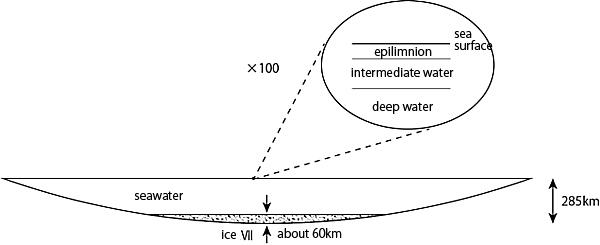Sea of Cubic Earth
The seas of our spherical Earth have much variety in depth. The depth of deep sea, however, is about 4 km in average, and about 10 km at the deepest point. Since the diameter of the Earth is 13,000 km, the depth of the sea corresponds to only 0.1 mm, which is the thickness for one sheet of paper, on a terrestrial globe of 30 cm in diameter.
On the other hand, the sea on the cubic Earth has a depth of about 300 km. On a cubic Earth model of the size of 30 cm, it becomes a thickness of about 1 cm (almost a thickness of a biscuit) (see Fig. 8).
Most of Seawater Stays Stable
The same amount of seawater, thinly spreading on the spherical Earth, forms a deep and small sea on the cubic Earth. The diameter of the sea on the cubic Earth is about of about 3500-km, 1/3 of the side length of the cubic Earth. This is very different from out spherical Earth, where the sea occupies about 70 percent of the surface.
Since the sea in the cubic Earth is small and centered on the equator, the highest latitude of the ocean is about that of Hawaii in our spherical Earth. The temperature of sea surface is almost uniform because the sea does not spread to near the South Pole nor the North Pole.
In our present Earth, the seawater is cooled and sinks near the North Pole or the South Pole and the convective circulation forms. In the cubic Earth, however, the density difference is so small that the convective circulation can’t penetrate deep sea of 300 km thick. Therefore, most of seawater stays stable.
At the bottom of the quiet, dark and deep sea, the pressure is terribly high. In this situation, the water will not boil at 100℃, but will be ice.

At the bottom of the sea, the seawater freezes to form ice-VII even in 100℃. Most of the seawater above it stays stable. Ocean currents exit only 2-3 km from the surface.



